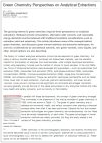What is Analytical Chemistry?
Analytical chemistry is the science of obtaining, processing, and communicating information about the composition and structure of matter. In other words, it is determining what matter is and how much of it exists.
How it’s related to green chemistry:
Many traditional analytical chemistry techniques, while effective, carry unintentional hazards such as using large quantities of harmful solvents in extractions. Analytical chemists using green chemistry practices choose or develop assessment methods that are efficient, generate minimal waste, and employ chemicals that are safe for humans and the environment. In addition, analytical chemists have an important role in evaluating the efficiency and safety of new and existing reactions and products. One example of a green analytical chemistry practice is analyzing only the minimum number of samples at the minimum sample size. This can decrease the amount of solvent needed and reduce waste.
For every bench synthesis and every industrial process there are many additional steps that require characterization. Analytical chemistry plays an important role in assessing how green a reaction or product is, and there is a rapidly growing field dedicated to making sure that the analysis itself is safe and efficient.
-
- Prevention – Choosing analytical methods that use the minimal amount of materials prevents waste and avoids treatment or clean-up after the fact
- Safer Solvents and Auxiliaries – Greener analytical chemistry involves avoiding auxiliary substances (e.g., solvents, separation agents, etc.) or using innocuous ones when necessary
- Real-Time Analysis of Pollution Prevention - Analytical chemists are essential for developing real-time, in-process monitoring and control methodologies that can be employed before hazardous substances form
- Inherently Safer Chemistry for Accident Prevention – Using safer solvents and preventing hazardous waste minimizes the potential for chemical accidents, including releases, explosions, and fires
-
HPLC-EAT
Researchers developed software called HPLC-EAT (Environmental Assessment Tool) to help analytical chemists determine the sustainability of high performance liquid chromatography (HPLC) methods based on solvent choice. The assessment includes environmental, health and safety considerations, and the tool is freely available online. The software can also be combined with a free life cycle assessment tool called EcoSolvent.
Eco-Scale
Eco-Scale is a semi-quantitative method for evaluating the greenness of each step in an analytical procedure. Unlike metrics such as Atom Economy and E-Factor, Eco-Scale was specifically designed for evaluating analytical chemistry. The assessment is intuitive, with a point-based penalty system for chemicals described with words like “dangerous” and “warning.” Factors like analyst exposure, volatility, waste treatment and energy use are also considered.
-

Green Chemistry Perspectives on Analytical Extractions
This recent paper discusses how solvent and energy considerations should be balanced with extraction yield and selectivity, and provides an overview of alternatives to conventional solvents and new green solvents for analytical extractions.

This paper presents an experiment that introduces several green chemistry principles and introduces natural product extraction, calibration curves, and pollution prevention and safety through alternative solvent selection.

Challenges in Green Analytical Chemistry
This book provides an assessment of the inefficiencies and safety concerns of contemporary analytical chemistry, and goes on to discuss approaches to making analysis greener.

Application of the Principles of Green Chemistry in Analytical Chemistry
In this paper, various separation methods are evaluated against the principles of green chemistry, with attention directed towards capillary electrophoresis, solvent replacement, and micronization.

Role of Process Analytical Technology in Green Chemistry and Green Engineering
An overview of how mechanisms for designing, analyzing and controlling manufacturing processes can minimize waste, improve reaction output, increase energy efficiency, decrease by-product formation, and reduce the risk of accidents.

Sustainable Analytical Chemistry—more than just being green (paid)
This paper emphasizes the difference between green and sustainable analytical chemistry by discussing examples of greening strategies for sample preparation, chromatography, and detection, as well as a review of solvents and green metrics.

Handbook of Green Analytical Chemistry
This comprehensive overview covers key concepts of green analytical, process techniques, strategies for reducing waste and energy, and fields of application.


